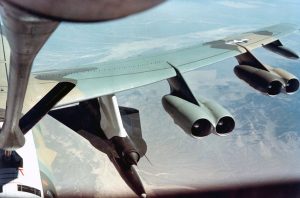1962, one of the Cold War’s Milestones, the Cuban’s Missiles Crisis and the Blockade, John Glenn the first american orbited the Earth in the NASA’s Mercury Program, Neil Armstrong as a test pilot, among others, flew with the X-15 plane to 40km altitudes and Mach 7 (Armstrong reached a 6.420 km/h speed), the Boeing 707 dominated the skies and The Beatles were rejected in an audition.
On the 1st of may of 1960, Francis Gary Powers were shot by the shock wave of fourteen SA-2 missiles that chased him, President Eisenhower had to admit to URSS premier Khrushchev that the U2 flight had a spying mission. Francis was exchanged for a soviet spy in 1962 and the direct U2 overflying were suspended, not near the coasts.
China started its nuclear program on 1959 and the Lop Nur Nuclear Test facilities were the target to photograph. Lop Nur is in the north east of China, near Mongolia, far far away from the Pakistan’s, european, turkish, and taiwanese U2 air bases, it was 3.300 km out of range even for the most experienced U2 pilots (the flew in missions up to 8 hours and 6.500 km) . The A12 were in development but it is needed more range without air re-fueling.
But again, Skunk Works were on the top of the plane’s development, the A12 (later the SR71 Blackbird) flew for the first time for reaching higher altitudes and five times faster than U2. In parallel, the genius engineers (Ben Rich and Kelly Johnson) start thinking about the first drone carried on top of an A12. This is the story.

Lockheed Martin D21 Drone on SR71 mothership. Source: en.wikipedia.org/wiki/Lockheed_D-21
These days the deals were promoted different as we do today, the secrecy in those years, the Cold War was in its apogee, and only a few companies had the technology and the experience of designing extreme planes. Skunk Works, the mythical Lockheed Martin’s secret division, managed by Kelly Johnson (Aeriaa note: I’m preparing an article about some of the best aeronautical engineers, of course K.Johnson will be in it), and proposed the drone idea to CIA (U2 were funded by CIA instead of US Air Force) but it was refused, so they tried with the US Air Force that finally put 500.000$ from their “contingency funds”. The drone specifications, firstly set by Skunk Works, were:
- At least 3.000 nautical miles range. (5.550 km)
- 6 inches (153mm) large-format photograph resolution. It was considered large format in the analog photography, more than 4 times a standard 35mm camera. Consider about 20 Mpx resolution for a 35mm camera, the 6 inches camera would have a resolution about 800 Mpx.
- Plus Mach 3 speed.
The D21 was built, as the its A12 mothership, in titanium and powered by a 50’s ground-to-air missile ramjet, one of the Skunk Works characteristics were the reutilization of components of other planes. The guidance system were fully automated with the signals stored in its servo actuators (Do I hear memory cards? :)) The camera and the sensitive payload were dropped by radio commands and after that the D21 was self-destructed. The camera and film fell by a parachute.
Finally on march 1963 (The Beatles release its first album :)), the project receive its launch, funded by CIA and US Air Force, 50 D21 were built until 1971.
The drone would be launched at full speed (Mach 3) and the aerodynamical, and shock wave, problems took the engineers busied for 6 months in the wind tunnel, three years later, on 1966 the D21 started to fly. After so so successful tests, the forth one was a catastrophe (watch the following video).
After this disaster they thought in using the B52 as the mothership, the had to increase 5 feet the length of the drone in order to increase its range, the ignition phase speed started 4 times below in a B52 than the A12. The B52 flew more than 16 hours, released the D21 and overflew the objectives at Mach 3.3, turn back an at Mach 1.6 released the payload (camera, films and flight control components) and self destroyed.

B52H carrying a D21B. (U.S. Air Force photo)
So, finally Nixon, on November 9, 1969 approved the first real mission, obviously Lop Nur Chinese nuclear facilities. The drone was not completed the mission, it crashed, but the radars did not detect it. It had the lowest radar signature ever get. (Please visit this aeriaa article about Stealth). There were three more flights over Lap nur, but the camera was never recovered, so the program were finally cancelled on 1971. They built 50 D21 drones. The first Chinese atomic bomb were tested on 1964, five years earlier of the first operational mission and 2 years after it was dreamed.
As a Cold War’s anecdote, on 1986, a CIA agent went to Skunk Works office, and showed to Ben Rich (the new manager) a piece, and said “Do you recognized this?”. Ben nodded, and ask where he got this, he replied that a KGB agent sent to him as a Christmas gift, it was recovered by a siberian shepherd. It was a panel of the first real mission of the D21 over China, the drone fell over Siberia.
So, this is the story of the beginnings of drones, a very controversial topic, in the military point of view nowadays, and more with the amazing first autonomous drone carrier landing by another autonomous drone as the D21, the X47B. It’s amazing.
Enjoy also this video of an U2 flight and its views. Do you imagine this in the Cold War’s years with SA-2 missiles and soviet fighters trying to reach the altitude for firing its missiles?
I hope you have enjoyed this article.
For more info and further reading I recommend you to read the book written by Ben Rich (former Skunk Works’ CEO).

D21 illustration by Lou Drendel. www.aviation-art.net
For more info:
Bibliography: Skunk Works. Ben Rich and Leo Janos.
About analog Vs Digital resolution: http://www.jonathangazeley.com/2011/02/how-many-megapixels-do-you-get-from-film/



